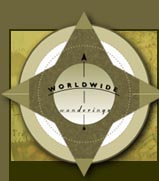|
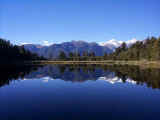 May 20-26, 1999 Middle South Island, New Zealand May 20-26, 1999 Middle South Island, New ZealandSouthern
Alps
One of the most enchanting charms of New Zealand is the exciting diversity
of its topography. Time and again, we've been able to drive from east coast to west coast
in a number of hours, and in so doing, see more changes in landscape and terrain than if
we'd spent days and days driving across our own country. How can this much beauty be
packed into this small of an area?
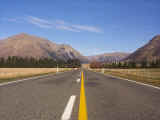 We soon find out that splendor sometimes comes directly from chaos. Specifically,
it seems that New Zealand's peaks and valleys, ridges and gorges, highlands and flatlands,
are all a direct product of the unstable and volatile plates of the earth's crust moving,
shifting, and rubbing together over the last few hundred thousand years. And it also seems
that one the most dramatic effects of this is shifting, is the line of sharp, rugged
mountains known as New Zealand's Southern Alps. We soon find out that splendor sometimes comes directly from chaos. Specifically,
it seems that New Zealand's peaks and valleys, ridges and gorges, highlands and flatlands,
are all a direct product of the unstable and volatile plates of the earth's crust moving,
shifting, and rubbing together over the last few hundred thousand years. And it also seems
that one the most dramatic effects of this is shifting, is the line of sharp, rugged
mountains known as New Zealand's Southern Alps.
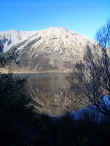 It's now mid afternoon as we approach this, the youngest
mountain range in the world. We're here at that absolutely magical time of day. The time
when the sun hangs in the sky just so, causing everything below it to glow in its
radiance. And glow things do, making the colors of Autumn seem especially rich. It's the
time of day when that big ball of fire in the heavens begins to play its wonderful tricks.
The burning mass splashes just enough of its gentle light on the west-most side of
everything to light it up - bringing out all the color without washing out any of the
hues; and at the same time throwing but a smidgen of its warm light on the eastern side of
things - lending to them both soft shadow and sharp contrast. It's now mid afternoon as we approach this, the youngest
mountain range in the world. We're here at that absolutely magical time of day. The time
when the sun hangs in the sky just so, causing everything below it to glow in its
radiance. And glow things do, making the colors of Autumn seem especially rich. It's the
time of day when that big ball of fire in the heavens begins to play its wonderful tricks.
The burning mass splashes just enough of its gentle light on the west-most side of
everything to light it up - bringing out all the color without washing out any of the
hues; and at the same time throwing but a smidgen of its warm light on the eastern side of
things - lending to them both soft shadow and sharp contrast.
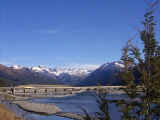 The collection of these shadows gives the tree covered
lower half of the mountains a gentle, bumpy texture. Below that, in the lower valley,
spots of burnt-orange moss covers some of the rocks, making them look as if they've been
spray-painted with the swoop of a giant hand. And in the distance, just beyond the
foothills and over the lengthy basin, we see the sunlight bouncing off of the powdered
sugar covered peaks of the Alps themselves. This creates a very enchanting optical
illusion, tricking us into thinking that we can just reach out and touch the peaks, even
though they're still miles away, at the far end of the valley. The collection of these shadows gives the tree covered
lower half of the mountains a gentle, bumpy texture. Below that, in the lower valley,
spots of burnt-orange moss covers some of the rocks, making them look as if they've been
spray-painted with the swoop of a giant hand. And in the distance, just beyond the
foothills and over the lengthy basin, we see the sunlight bouncing off of the powdered
sugar covered peaks of the Alps themselves. This creates a very enchanting optical
illusion, tricking us into thinking that we can just reach out and touch the peaks, even
though they're still miles away, at the far end of the valley.
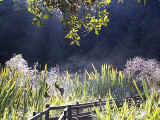 We drive on, through the foothills and into the mountainous foliage. Our path is
suddenly lined with light forest. Those trees which have already lost their leaves,
reflect white along the sunny side of each shiny, naked branch; while others, still laden
with needles, disperse the shower of light into a million different directions. As we wind
still deeper into the mountain pass, the forest quickly becomes more dense, more dark,
more lush, more green. We drive on, through the foothills and into the mountainous foliage. Our path is
suddenly lined with light forest. Those trees which have already lost their leaves,
reflect white along the sunny side of each shiny, naked branch; while others, still laden
with needles, disperse the shower of light into a million different directions. As we wind
still deeper into the mountain pass, the forest quickly becomes more dense, more dark,
more lush, more green.
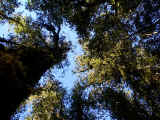 At this point, little sunlight makes it over the towering
mountain peaks, through the thick tarp of leaves, and to the fern covered ground below.
The trucks of these trees are covered with moist moss. In this cool and damp environment,
the vegetation grows thick, fed by spring water, seeping out and down through cracks in
the occasionally exposed rock walls. This same spring trickle eventually makes its way
into flowing rivers, and then finally, into small lakes of crystal clear, perfectly still
mountain water. At this point, little sunlight makes it over the towering
mountain peaks, through the thick tarp of leaves, and to the fern covered ground below.
The trucks of these trees are covered with moist moss. In this cool and damp environment,
the vegetation grows thick, fed by spring water, seeping out and down through cracks in
the occasionally exposed rock walls. This same spring trickle eventually makes its way
into flowing rivers, and then finally, into small lakes of crystal clear, perfectly still
mountain water.
Laura and I park the van for a quick stroll around one such lake, Lake
Matheson. A few minutes into our trek, we pop around a bend and continue down the trail
towards the waterside.
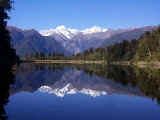 Then, there it is . . . the most brilliantly
picturesque panorama that I think I have ever seen, or for that matter, ever imagined. The
strikingly magnificent image of the perfectly-at-rest waters - reflecting the snow capped
peaks of Mt. Cook and Mt. Tasman, towering majestically in the center of the surrounding
evergreen slopes - literally takes my breath away. I can't speak. I can't move. I can only
stand here, in respectful silence and absolute reverence. Stand here in wonder and
amazement of the incredible beauty that nature has created. Then, there it is . . . the most brilliantly
picturesque panorama that I think I have ever seen, or for that matter, ever imagined. The
strikingly magnificent image of the perfectly-at-rest waters - reflecting the snow capped
peaks of Mt. Cook and Mt. Tasman, towering majestically in the center of the surrounding
evergreen slopes - literally takes my breath away. I can't speak. I can't move. I can only
stand here, in respectful silence and absolute reverence. Stand here in wonder and
amazement of the incredible beauty that nature has created.
Makarora
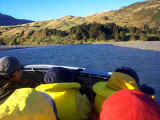 He
cuts a hard left. My face is splashed with spray, completely covering my glasses with a
light mist. I don't even bother lifting my hand to wipe them off, but for now just squint
through the droplets, knowing that the 50 mph wind plowing into my face will have them dry
again in no time. In truth, I'm hesitant to wipe them off, because doing so would mean I'd
need to release my white-knuckle grip on the railing in front of me. And that in turn,
could likely result in being thrown from our little rocket-craft during one of its inertia
defying turns. He
cuts a hard left. My face is splashed with spray, completely covering my glasses with a
light mist. I don't even bother lifting my hand to wipe them off, but for now just squint
through the droplets, knowing that the 50 mph wind plowing into my face will have them dry
again in no time. In truth, I'm hesitant to wipe them off, because doing so would mean I'd
need to release my white-knuckle grip on the railing in front of me. And that in turn,
could likely result in being thrown from our little rocket-craft during one of its inertia
defying turns.
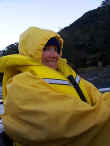 No, we're not riding on the newest amusement park ride, or in the latest virtual
reality video game, we're part of an early morning run of an experience that's uniquely
Kiwi - the experience of ultra-shallow water river jet boating on the Makarora and glacier
fed Wilkin Rivers. Sure enough, it's only minutes before the cold, harsh wind dries my
glasses off again, giving me full sight of the blurred mountain river scenery that we're
zipping rapidly past. Unfortunately, this chilly 'breeze' has also completely numbed my
jaw, making even my screams sound oddly slurred. And then the whole boat load of us let
out a load "WHOAAA!" as we suddenly whip towards the right, heading back in the
opposite direction. No, we're not riding on the newest amusement park ride, or in the latest virtual
reality video game, we're part of an early morning run of an experience that's uniquely
Kiwi - the experience of ultra-shallow water river jet boating on the Makarora and glacier
fed Wilkin Rivers. Sure enough, it's only minutes before the cold, harsh wind dries my
glasses off again, giving me full sight of the blurred mountain river scenery that we're
zipping rapidly past. Unfortunately, this chilly 'breeze' has also completely numbed my
jaw, making even my screams sound oddly slurred. And then the whole boat load of us let
out a load "WHOAAA!" as we suddenly whip towards the right, heading back in the
opposite direction.
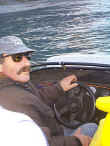 This time, our driver warns us
with a loud "Now 'old on mates!!" and cuts hard on the wheel. Once again, the
seven of us yell out in unison "WHOOOAAAAA!!" while the front-end of the small
craft stops, as if glued in place, while the tail-end lifts up into the air,
simultaneously whipping all the way around in one of the jet-boat's notorious,
split-second, 360 degree turns. As we're slammed up against the unforgiving aluminum side
of the cockpit, I wonder whether our spot (the only two passengers in the rear-most of
three bench seats) is the best, or rather worst place to be. I ponder this thought for oh
but a moment, before the little boat throws our heads back during its lunge forward and
toward full speed. Its agility isn't surprising when you consider that our light, tiny
craft is powered by a modified Chevy 350 powerplant that burns through fuel at an alarming
rate of 60 liters an hour. Apparently, it takes that kind of power to pump up to 26,000
liters of water A MINUTE through the boat's internal turbine or impeller. The unique
design of both craft and engine let it go places that would prove impossible for most
other craft. Good thing too, I think to myself, as we zip along over rocks atop as little
as 4 inches of water. And all this at speeds of up to 50-55 mph!! This time, our driver warns us
with a loud "Now 'old on mates!!" and cuts hard on the wheel. Once again, the
seven of us yell out in unison "WHOOOAAAAA!!" while the front-end of the small
craft stops, as if glued in place, while the tail-end lifts up into the air,
simultaneously whipping all the way around in one of the jet-boat's notorious,
split-second, 360 degree turns. As we're slammed up against the unforgiving aluminum side
of the cockpit, I wonder whether our spot (the only two passengers in the rear-most of
three bench seats) is the best, or rather worst place to be. I ponder this thought for oh
but a moment, before the little boat throws our heads back during its lunge forward and
toward full speed. Its agility isn't surprising when you consider that our light, tiny
craft is powered by a modified Chevy 350 powerplant that burns through fuel at an alarming
rate of 60 liters an hour. Apparently, it takes that kind of power to pump up to 26,000
liters of water A MINUTE through the boat's internal turbine or impeller. The unique
design of both craft and engine let it go places that would prove impossible for most
other craft. Good thing too, I think to myself, as we zip along over rocks atop as little
as 4 inches of water. And all this at speeds of up to 50-55 mph!!
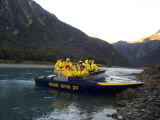 Luckily, we're not going quite that fast when we turn and head UP stream - over
seemingly impassible rock-strewn rapids. Our skilled and practiced pilot guides us right,
then left, then back to the right again, as we lightly bounce along, atop what can't be
more that 5-6 inches of glacier stream. And then, just over the last crest of the rapids,
our pilot decides to have a little fun with us. He dives straight towards the overhanging
river bank, then suddenly, at the last possible moment, turns away on a dime. He then
peppers that excitement with a few skirts aside each side of the river's shore. One time,
we get so close that I'm sure I can reach out and literally touch the bank (if only I
wasn't worried about getting my are ripped out of its socket in the process). Luckily, we're not going quite that fast when we turn and head UP stream - over
seemingly impassible rock-strewn rapids. Our skilled and practiced pilot guides us right,
then left, then back to the right again, as we lightly bounce along, atop what can't be
more that 5-6 inches of glacier stream. And then, just over the last crest of the rapids,
our pilot decides to have a little fun with us. He dives straight towards the overhanging
river bank, then suddenly, at the last possible moment, turns away on a dime. He then
peppers that excitement with a few skirts aside each side of the river's shore. One time,
we get so close that I'm sure I can reach out and literally touch the bank (if only I
wasn't worried about getting my are ripped out of its socket in the process).
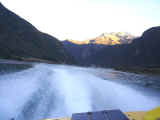 Then, before we know it, we're headed back down
the river the same way that we came up. And as if there's any way it can be, the quick
trip back down the rapids is even more thrilling. We're again thrown from side to side,
zigzagging through rocks, boulders, limbs and stumps, but this time, it seems even faster.
We whiz over the shallow water, whipping back and forth, flying in and out - like a like a
little digital boat in a video game. Only this ride is for real. It must be - I mean - in
the virtual world you don't usually walk away with a nearly frostbitten face, or for that
matter matching bruises on both your hips, do you? Then, before we know it, we're headed back down
the river the same way that we came up. And as if there's any way it can be, the quick
trip back down the rapids is even more thrilling. We're again thrown from side to side,
zigzagging through rocks, boulders, limbs and stumps, but this time, it seems even faster.
We whiz over the shallow water, whipping back and forth, flying in and out - like a like a
little digital boat in a video game. Only this ride is for real. It must be - I mean - in
the virtual world you don't usually walk away with a nearly frostbitten face, or for that
matter matching bruises on both your hips, do you?
|
